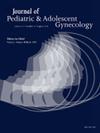18. Bilateral Borderline Ovarian Tumors in a 15-Year-Old: A Rare Pediatric Case
IF 1.7
4区 医学
Q3 OBSTETRICS & GYNECOLOGY
引用次数: 0
Abstract
Background
Ovarian malignancy in pediatrics, with germ cell tumors being most common, is reported in 3–8% of patients. Borderline tumors, a type of tumor with low malignant potential showing cytologic traits of malignancy but lacking clear invasive growth, occur at even lower rates with no consistent statistical data reported. Pediatric bilateral borderline ovarian tumors (BOTs) have not been well described in the literature beyond case reports.
Case
A 15-year-old female presented to her pediatrician for a routine annual exam which revealed abdominal distention on physical exam. This prompted an abdominal x-ray and CT abdomen/pelvis which identified a 23 × 17.5 × 10.3cm cystic mass stemming from the left ovary. She initially did not report any complaints, but upon reflection, she stated that she felt distended one month prior and reported a ten-pound weight gain, fatigue, urinary frequency, light-headedness, and discomfort when stooling over the last two months. She underwent menarche at age 12 and denied any significant past medical or surgical history. She was referred to pediatric surgery for further evaluation. Tumor markers were significant for a slightly elevated CA125 (87) and inhibin-A just above normal limits (106). AFP, bHCG, LDH, and inhibin B were within normal limits. Her pelvic ultrasound noted a normal uterus, no free fluid, and a large multicystic and solid mass arising from the pelvis to the level of the liver. Due to the size of the mass, her ovaries were difficult to specifically delineate. The patient subsequently underwent an exploratory laparotomy that unexpectedly revealed masses on both ovaries, with the right mass appearing benign in the operating room and the left ovarian mass with concerning solid components and increased vascularity. Pelvic washings were obtained followed by ovarian-sparing excision of bilateral ovarian masses. Pathologic specimens were reviewed at the primary institution and sent for secondary review at an institution that specializes in pediatric ovarian pathology. The patient's pelvic washings were negative. The final diagnoses of the left (208.2g 18.5 × 14.8 × 3.2cm) and right (365 g 9.6 × 9.0 × 7.2cm) ovarian masses were proliferative serous BOTs.
Comments
This is an example of an extremely rare clinical scenario of bilateral serous BOTs in a pediatric patient. The case demonstrates the importance of an extensive preoperative workup for an abdominopelvic mass including imaging and laboratory assessment, collaboration of teams in the operating room and postoperatively, removal of masses without spillage in the abdominal cavity, and the significance of fertility preservation with ovarian-sparing mass excisions.
18. 15岁患儿双侧边缘性卵巢肿瘤:一例罕见的儿科病例
背景:小儿卵巢恶性肿瘤以生殖细胞肿瘤最为常见,约占患者的3-8%。交界性肿瘤是一种低恶性潜能的肿瘤,表现出恶性肿瘤的细胞学特征,但缺乏明确的侵袭性生长,发病率更低,但没有一致的统计数据报道。儿童双侧交界性卵巢肿瘤(BOTs)在文献中没有很好的描述,除了病例报告。病例:一名15岁的女性向她的儿科医生进行常规年度检查,体检时发现腹胀。这促使腹部x线和腹部/骨盆CT发现一个23 × 17.5 × 10.3cm的囊性肿块起源于左卵巢。她最初没有报告任何抱怨,但经过反思,她说她在一个月前感到腹胀,并报告在过去两个月里体重增加了10磅,疲劳,尿频,头晕,大便不舒服。她在12岁时月经初潮,并否认有任何重大的病史或手术史。她被转到儿科外科做进一步的评估。肿瘤标志物CA125轻微升高(87),抑制素- a略高于正常水平(106)。AFP、bHCG、LDH、抑制素B均在正常范围内。盆腔超声检查显示子宫正常,无游离液体,有一大块多囊性实性肿块,从盆腔延伸至肝脏。由于肿块的大小,她的卵巢很难具体描绘。患者随后进行剖腹探查,意外发现双卵巢肿块,右侧肿块在手术室显示为良性,左侧卵巢肿块有实心成分,血管增多。盆腔清洗后,保留卵巢切除双侧卵巢肿块。病理标本在主要机构进行检查,并送到专门从事儿科卵巢病理的机构进行二次检查。患者盆腔冲洗阴性。左侧(208.2g 18.5 × 14.8 × 3.2cm)和右侧(365 g 9.6 × 9.0 × 7.2cm)卵巢肿块最终诊断为增生性浆液性bot。这是一个极为罕见的儿科患者双侧浆液性bot的临床病例。该病例证明了广泛的术前检查对腹部盆腔肿块的重要性,包括影像学和实验室评估,手术室和术后团队的合作,在腹腔内不扩散的情况下切除肿块,以及通过保留卵巢的肿块切除来保留生育能力的重要性。
本文章由计算机程序翻译,如有差异,请以英文原文为准。
求助全文
约1分钟内获得全文
求助全文
来源期刊
CiteScore
3.90
自引率
11.10%
发文量
251
审稿时长
57 days
期刊介绍:
Journal of Pediatric and Adolescent Gynecology includes all aspects of clinical and basic science research in pediatric and adolescent gynecology. The Journal draws on expertise from a variety of disciplines including pediatrics, obstetrics and gynecology, reproduction and gynecology, reproductive and pediatric endocrinology, genetics, and molecular biology.
The Journal of Pediatric and Adolescent Gynecology features original studies, review articles, book and literature reviews, letters to the editor, and communications in brief. It is an essential resource for the libraries of OB/GYN specialists, as well as pediatricians and primary care physicians.

 求助内容:
求助内容: 应助结果提醒方式:
应助结果提醒方式:


